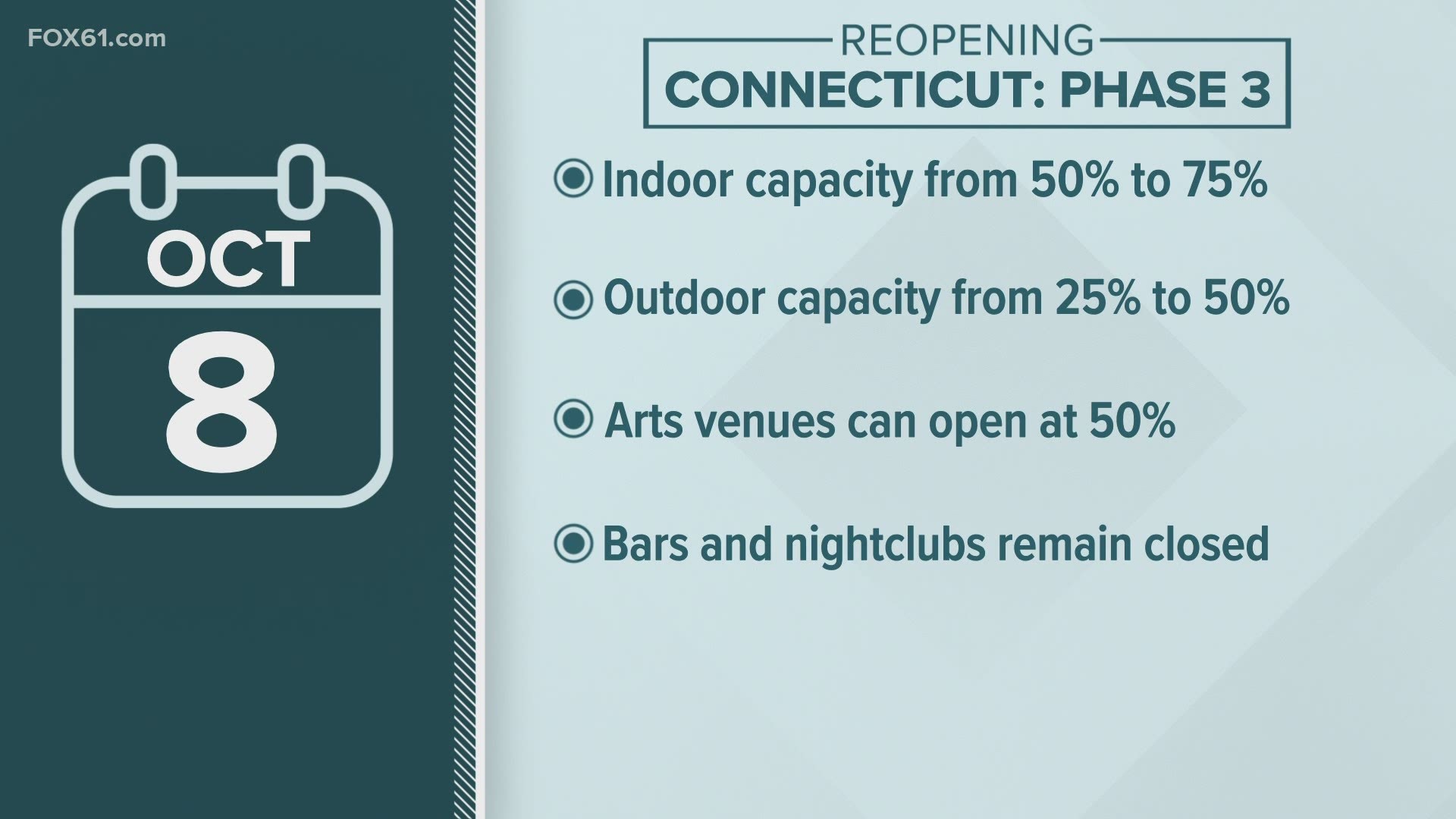HARTFORD, Conn — Governor Lamont announced on Thursday afternoon that Connecticut will begin Phase 3 in its reopening plan. Lamont said the new Phase will begin on October 8.
The new Phase will increase capacity across multiple gatherings, businesses, and religious events.
“The reason why we are able to have a discussion about even entering into Phase 3 is because of Connecticut residents’ collective actions to fight the spread of COVID-19,” Governor Lamont said. “By taking the sector rules seriously, wearing masks, physically distancing, and washing your hands regularly, I believe that we can continue to keep these rates low while also easing some of the restrictions that were enacted earlier this year. I applaud the residents of our state for what they’ve been doing, and urge them to keep it up.”
For businesses like restaurants, barbers shops, and libraries, the indoor capacity has increased from 50 percent to 75 percent. Outdoor events like a race track will see an increase from 25 percent to 50 percent with mask-wearing and social distancing be practiced.
Bars and nightclubs will continue to stay closed. When asked if there was a timeline to reopen these types of businesses, Lamont said there is not one.
Indoor performing venues will increase capacity to 100 people. Private outdoor events will go from 100 to 150 people. Graduations and religious venues will also see an increase in capacity. Graduations will see an increase to 50 percent or 200 people. Religious venues will also see an increase to 50% capacity or 200 people.
Chief Operating Officer Josh Geballe also said changes in nursing home visitation regulations could come Friday. The Federal government has changed its guidance and Connecticut is reviewing its own guidelines.
To view the press conference, click here.
The Connecticut Restaurant Association released its statement thanking Lamont on the decision to begin Phase 3:
“Today’s news is another important step in Connecticut’s nation-leading efforts to respond to COVID-19 in a safe and responsible manner. Like the rest of the country, Connecticut is not out of the woods of this pandemic by any stretch, but we've proven that it’s possible to be mindful of our local economy at the same time we keep our residents as safe as possible.
It’s important to keep in mind that Connecticut returned to limited indoor dining on June 17. That means that for more than three months, customers throughout the state have been dining indoors while Connecticut has held COVID transmission to some of the lowest levels in the country. Connecticut restaurateurs have proven their ability to adapt, follow new rules, and serve customers safely. Today’s news is a recognition of their hard work and commitment to being part of the solution, and a recognition that the state must help a sector that at its peak employed 10% of the state’s workforce.
We want to thank Governor Lamont, Commissioner Lehman, and the rest of their administration for their continued partnership and communication on these issues. Connecticut restaurants will need more help to make it through this difficult time, but the Governor has found ways to keep our industry and others moving ahead of other states, and to do it safely. We look forward to continued work with his administration in the weeks and months ahead."
The Governor's office released the recent COVID-19 statistics Thursday showing a slight decrease in positivity rate. Connecticut administered 15,562 and 157 of the tests came back positive, yielding a positivity rate of about 1 percent. Lamont mentioned during the press conference, it took Connecticut almost five months to get to 1 million tests administered and about a month and a half to get to 1.5 million tests.
There are 72 patients currently being treated for the COVID-19. There were two more people who died due to the virus, increasing the death toll to 4,499 people.
Earlier Thursday, Gov. Lamont, Lt. Gov. Bysiewicz, and Connecticut Agriculture officials announced the launch of CTPantryResources.com.
According to a release, the initiative allows food pantries in need to visit that site and connect to resources on food procurement and distribution, volunteer assistance, shipping, and storage supports, and more.

